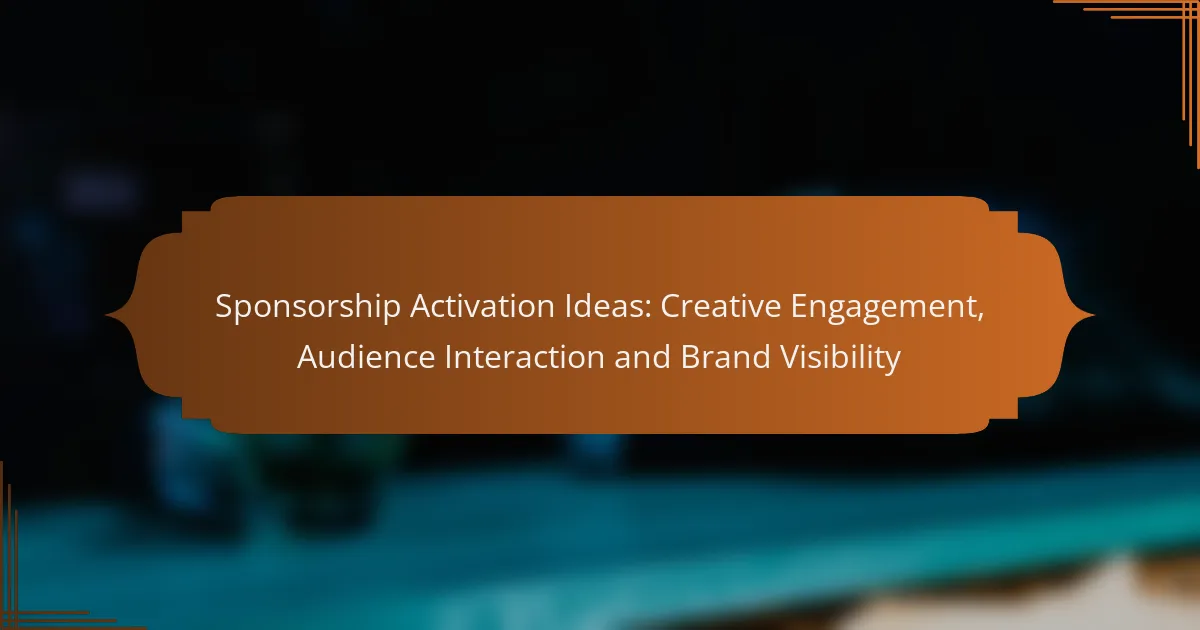Sponsorship packages are designed to maximize brand exposure and engagement through essential elements such as visibility, audience interaction, and exclusive access. The pricing models for these packages vary, impacting both the sponsor’s investment and the event’s revenue. Ultimately, these packages offer compelling value propositions that can enhance brand loyalty, create networking opportunities, and drive sales growth.

What Are the Key Elements of Sponsorship Packages?
Sponsorship packages typically include several essential elements that enhance brand exposure and engagement. Key components include brand visibility, audience engagement, exclusive access, content integration, and performance metrics, all of which contribute to the overall value proposition for sponsors.
Brand Visibility
Brand visibility refers to how prominently a sponsor’s brand is displayed across various platforms and events. This can include logos on promotional materials, signage at events, and mentions in media coverage. Effective sponsorship packages should offer multiple touchpoints to maximize exposure.
Consider including options for digital visibility, such as social media promotions or website placements, which can significantly increase reach. A well-structured package might offer visibility in both physical and online spaces to cater to diverse audiences.
Audience Engagement
Audience engagement measures how effectively a sponsor connects with the target demographic. This can involve interactive experiences, contests, or exclusive content that encourages participation. Engaging the audience can lead to stronger brand loyalty and recognition.
To enhance engagement, consider incorporating experiential marketing strategies, such as live demonstrations or meet-and-greet opportunities. These elements can create memorable interactions that resonate with attendees and foster a deeper connection with the brand.
Exclusive Access
Exclusive access provides sponsors with unique opportunities that are not available to others, such as VIP events or private networking sessions. This exclusivity can enhance the perceived value of the sponsorship and attract higher-tier sponsors willing to invest more.
When designing sponsorship packages, think about offering tiered levels of access. For instance, top-tier sponsors might receive backstage passes or one-on-one time with key speakers, while lower tiers could have access to general networking events.
Content Integration
Content integration involves seamlessly incorporating the sponsor’s brand into the event’s content, such as presentations, videos, or promotional materials. This approach can enhance the authenticity of the sponsorship and create a more cohesive experience for the audience.
Consider developing co-branded content that highlights both the event and the sponsor. This could include sponsored blog posts, videos, or social media content that aligns with the event’s theme while promoting the sponsor’s message.
Performance Metrics
Performance metrics are essential for evaluating the success of a sponsorship package. These metrics can include reach, engagement rates, and conversion statistics, providing sponsors with tangible evidence of their investment’s effectiveness.
To ensure accountability, establish clear KPIs (Key Performance Indicators) before the event. Regularly reporting on these metrics post-event can help sponsors assess their return on investment and inform future sponsorship decisions.

How Do Sponsorship Pricing Models Work?
Sponsorship pricing models determine how sponsors are charged for their support, influencing both the sponsor’s investment and the event’s revenue. These models can vary widely, with different structures offering unique benefits and considerations for both parties involved.
Tiered Pricing
Tiered pricing involves creating multiple sponsorship levels, each with distinct benefits and costs. For example, a basic package might start at a few thousand dollars, while premium tiers could exceed tens of thousands, offering additional visibility and perks.
This model allows sponsors to choose a level that fits their budget and marketing goals. However, it’s essential to clearly define what each tier includes to avoid confusion and ensure perceived value aligns with the cost.
Flat Rate Pricing
Flat rate pricing sets a single price for sponsorship, regardless of the benefits offered. This straightforward approach simplifies budgeting for sponsors, as they know exactly what they will pay upfront.
While this model can attract sponsors looking for predictability, it may not maximize revenue potential if the benefits provided do not match the price point. Event organizers should carefully assess the value of the offerings to ensure they are competitive.
Percentage of Revenue
In a percentage of revenue model, sponsors pay a predetermined percentage of the revenue generated from the event. This model aligns the interests of both the sponsor and the event organizer, as both parties benefit from higher sales.
However, this approach requires accurate tracking of revenue and can complicate financial forecasting. It’s crucial to establish clear terms regarding what constitutes revenue and how it will be calculated to avoid disputes later on.

What Value Propositions Do Sponsorship Packages Offer?
Sponsorship packages provide significant value propositions that enhance brand visibility, foster customer loyalty, and create networking opportunities. These benefits can lead to increased sales and stronger market positioning for sponsors.
Increased Brand Awareness
One of the primary value propositions of sponsorship packages is increased brand awareness. By associating with events or organizations, sponsors can reach a wider audience and enhance their visibility in the market. This is particularly effective in high-traffic environments where potential customers are already engaged.
To maximize brand awareness, sponsors should consider the alignment of their brand with the event’s audience. For example, a tech company sponsoring a major tech conference can effectively reach tech-savvy consumers. Utilizing social media and promotional materials during the event can further amplify brand recognition.
Enhanced Customer Loyalty
Sponsorship packages can also enhance customer loyalty by creating positive associations between the brand and the sponsored event or cause. When customers see a brand actively supporting their interests or communities, they are more likely to develop a sense of loyalty towards that brand.
To leverage this, sponsors should engage with their audience through meaningful interactions during the event. Offering exclusive promotions or experiences can strengthen this loyalty. For instance, a beverage company providing free samples at a local sports event can create a lasting impression and encourage repeat purchases.
Networking Opportunities
Sponsorship packages often provide valuable networking opportunities for sponsors. By participating in events, sponsors can connect with potential clients, partners, and industry leaders, which can lead to new business opportunities and collaborations.
To make the most of these networking opportunities, sponsors should actively engage with attendees and other sponsors. Setting clear goals for networking, such as collecting a specific number of business cards or scheduling follow-up meetings, can help maximize the benefits of these interactions. Additionally, hosting a booth or a special event can facilitate more meaningful connections.

What Are the Best Practices for Creating Sponsorship Packages?
Creating effective sponsorship packages involves understanding your audience, aligning with brand goals, and offering customization options. These best practices ensure that both sponsors and the event or organization benefit from a mutually rewarding partnership.
Define Target Audience
Identifying the target audience is crucial for crafting relevant sponsorship packages. Understand the demographics, interests, and behaviors of the audience to tailor offerings that resonate with potential sponsors.
Consider conducting surveys or analyzing past event data to gather insights. This information helps in creating packages that appeal to sponsors looking to reach specific groups, enhancing the likelihood of successful partnerships.
Align with Brand Goals
Sponsorship packages should align with the strategic goals of both the sponsor and the event. Clearly outline how the sponsorship will help the brand achieve its objectives, whether it’s increasing brand awareness, driving sales, or enhancing community engagement.
For example, if a sponsor aims to promote a new product, highlight opportunities for product sampling or exclusive promotions within the package. This alignment ensures that both parties see value in the collaboration.
Offer Customization Options
Providing customization options within sponsorship packages can significantly enhance appeal. Allow sponsors to choose from various levels of engagement, such as logo placements, speaking opportunities, or exclusive access to certain event areas.
Flexibility in package offerings can cater to different budget ranges and marketing strategies. Consider creating tiered packages that provide basic options with add-ons, enabling sponsors to tailor their involvement based on their specific needs and goals.

How to Measure the Success of Sponsorship Packages?
Measuring the success of sponsorship packages involves analyzing various performance indicators that reflect the effectiveness of the partnership. Key metrics include return on investment (ROI), engagement levels, and brand sentiment, which together provide a comprehensive view of the sponsorship’s impact.
ROI Analysis
ROI analysis quantifies the financial return generated from a sponsorship relative to its cost. To calculate ROI, divide the net profit from the sponsorship by the total investment and multiply by 100 to get a percentage. A positive ROI indicates a successful sponsorship, while a negative ROI suggests a need for reevaluation.
Consider setting benchmarks based on industry standards. For example, a successful sponsorship might aim for an ROI of 20% or higher. Regularly reviewing these figures helps in adjusting strategies for future sponsorships.
Engagement Metrics
Engagement metrics assess how well the target audience interacts with the sponsored content or event. Key indicators include social media shares, event attendance, website traffic, and direct inquiries related to the sponsorship. Tracking these metrics can reveal the level of interest and involvement generated by the sponsorship.
Utilize tools like Google Analytics for web traffic or social media analytics platforms to measure engagement. Aim for specific targets, such as a 30% increase in social media interactions during the sponsorship period, to gauge effectiveness.
Brand Sentiment Tracking
Brand sentiment tracking evaluates public perception of a brand before, during, and after a sponsorship. This can be done through surveys, social media monitoring, and sentiment analysis tools that gauge positive, negative, or neutral feelings towards the brand. Understanding sentiment helps in assessing the sponsorship’s impact on brand image.
Regularly conducting sentiment analysis can help identify trends and shifts in public opinion. For instance, a notable increase in positive sentiment following a sponsorship event can indicate successful brand alignment with the audience’s values and interests.



